Multi-Source Data-Driven Identification and Spatial Optimization of Rural Settlements: Evidence from Sangxu, China
Abstract
1. Introduction
2. Materials and Methods
2.1. Study Area
2.2. Data Acquisition and Processing
2.3. Research Process
2.3.1. Research Framework
2.3.2. Classification of Rural Settlements
- Evaluation of Comprehensive Development Levels
- Resident Activity Intensity
- Infrastructure Levels
- a.
- Coverage of Public Service Facilities
- b.
- Density of Commercial Service Facilities
2.3.3. Methods for Layout Optimization of Rural Settlements
- Principle of Layout Optimization
- Analysis of Spatial Point Pattern
- Combination Model for Layout Optimization
- a.
- Voronoi Diagram Definition
- b.
- Weighted Voronoi Diagram Definition
- c.
- Extended Breakpoint Model
- d.
- Weighted Voronoi Diagram and Extended Breakpoint Combination Model
3. Results
3.1. Identification of Rural Settlements’ Type
3.1.1. Characteristic Analysis of Nighttime Lighting Data and POI Data
3.1.2. Characteristic Protection-Type Settlements
3.1.3. Evaluation of Comprehensive Development Level
3.1.4. Classification of Rural Settlement Type
- (1)
- Suburban integration-type settlements are located in close proximity to the town center, primarily distributed along both sides of major roads, and exhibit significant location advantages. These settlements are characterized by larger scales, higher population densities, and relatively well-developed public services and infrastructure, which generally meet the daily needs of both local and surrounding rural residents.
- (2)
- Agglomeration and upgrading-type settlements are situated at a moderate distance from the town center, with the exception of Daxingzhuang, all of which are adjacent to Provincial Highway 245, and benefit from convenient transportation and certain location advantages. These settlements exhibit larger scales and higher population densities. The concentration of numerous wood processing enterprises has effectively promoted local employment in these areas.
- (3)
- Control and retention-type settlements are predominantly distributed along the banks of the Youyi River and Shuxin River, with relatively close proximity to the town’s main roads, which provide these areas with certain location advantages. Compared to suburban integration-type and agglomeration and upgrading-type settlements, these villages host fewer industrial enterprises and primarily focus on the cultivation of Prunus triloba as their dominant industry. However, the lack of adequate public services and infrastructure in such settlements hinders their ability to fully meet their residents’ daily needs.
- (4)
- Relocation and consolidation-type settlements are fewer in number and smaller in scale. These villages are primarily located along the Huangni River in the western part of the town and the Gupo River in the south, far from major roads and the town center, resulting in unfavorable location conditions. These settlements lack industrial support and rely primarily on traditional crops such as rice, wheat, and corn, leading to lower levels of economic development.
- (5)
- Characteristic protection-type settlements include Xinshunhe Village (Santai), Tiaohe Village (Miaopu), Shuyao Village (Shuyao), and Erxing Village (Machangzhuang).
3.2. Layout Optimization of Rural Settlements
3.2.1. Identifying the Optimal Relocation Distance for Rural Settlements
3.2.2. Determining the Influence Range of Development-Type Settlements
3.2.3. Determining the Relocation Direction of Removal-Type Settlements
3.3. Optimization Paths for Different Types of Rural Settlements
3.3.1. Suburban Integration-Type
3.3.2. Agglomeration and Upgrading-Type
3.3.3. Control and Retention-Type
3.3.4. Characteristic Protection-Type
3.3.5. Removal-Type
4. Discussion
4.1. Methodological Advantages of Multi-Source Data
4.2. Nighttime Light Data Reflects the Activity Intensity of Rural Residents with Accuracy Verification Based on Field Investigation
4.3. Main Application and Reflection of the Research Results
4.4. Research Limitations and Future Directions
5. Conclusions
Author Contributions
Funding
Institutional Review Board Statement
Informed Consent Statement
Data Availability Statement
Acknowledgments
Conflicts of Interest
References
- Qu, Y.B.; Dong, X.Z.; Ping, Z.L.; Guan, M. Quality evaluation and improvement strategies of rural residential areas utilization from the perspective of human and land coordination. Trans. Chin. Soc. Agric. Eng. (Trans. CSAE) 2021, 37, 252–262. [Google Scholar] [CrossRef]
- Duan, Y.Q.; Chen, S.; Zhang, L.D.; Wang, D.; Liu, D.Y.; Hou, Q.H. Spatial Distribution Characteristic and Type Classification of Rural Settlements: A Case Study of Weibei Plain, China. Sustainability 2023, 15, 8736. [Google Scholar] [CrossRef]
- Guo, Y.Z.; Liu, Y.S. The process of rural development and paths for rural revitalization in China. Acta Geogr. Sin. 2021, 76, 1408–1421. [Google Scholar] [CrossRef]
- Zou, Y.F.; Yi, C.F.; Luo, F.; Du, P.P.; Liu, H.Y.; Chen, T.; Song, Y.; Wu, P.Q.; Zhou, Y. Revitalization paths for different types of rural settlements based on life cycle theory: A case study of a township in the farming-pastoral ecotone of northern China. Habitat Int. 2025, 163, 103461. [Google Scholar] [CrossRef]
- Ma, L.B.; Liu, S.C.; Tao, T.M.; Gong, M.; Bai, J. Spatial reconstruction of rural settlements based on livability and population flow. Habitat Int. 2022, 126, 102614. [Google Scholar] [CrossRef]
- Cai, E.X.; Long, S.H.; Li, L.; Luo, Y.; Ge, L.L.; Chen, W.Q.; Li, G.Q. Optimization of Rural Residential Areas in Flood Detention Basins Based on Dual Minimum Accumulation Resistance Model: A Case Study of Xun County in Central China. Land 2024, 13, 2217. [Google Scholar] [CrossRef]
- Ye, Y.M.; Zhang, X.B.; Lin, Q.; Lin, F.F. A weighted setcovering problem model for optimal spatial layout of rural settlements: A case of Liusi town. Econ. Geogr. 2017, 37, 140–148. [Google Scholar]
- Li, X.D.; Yang, Y.; Yang, B.; Zhao, T.; Yu, Z.Y. Layout optimization of rural settlements in mountainous areas based on farming radius analysis. Trans. Chin. Soc. Agric. Eng. (Trans. CSAE) 2018, 34, 267–273. [Google Scholar] [CrossRef]
- Zhong, Q.K.; Xie, L.; Wu, J.D. Reimagining heritage villages’ sustainability: Machine learning-driven human settlement suitability in Hunan. Humanit. Soc. Sci. Commun. 2025, 12, 661. [Google Scholar] [CrossRef]
- Shi, Y.; Zhu, X.W.; Li, J.H.; Ma, X.Y.; Zhao, N. Optimal Layout of Rural Settlements in Gully Areas of the Loess Plateau Based on Multi-agent Bodies. Econ. Geogr. 2023, 43, 170–178. [Google Scholar] [CrossRef]
- Hassan, A.W.; Zhang, D.R.; Guan, Y.Q.; Ahmed, A.; Ifeanyi, C.O. Assessment of the Suitability of Water Quality Condition for Drinking and Irrigation Uses in African Urban Informal Settlements: Case Study Zaria Metropolis. Water Air Soil Pollut. 2025, 236, 436. [Google Scholar] [CrossRef]
- Zou, Y.F.; Luo, F.; Rao, Y.F.; Yi, C.F.; Wu, P.Q. Optimizing the spatial layout of rural settlements in Farming-pastoral Zone under factor endowment and mobility. Trans. Chin. Soc. Agric. Eng. (Trans. CSAE) 2023, 39, 245–255. [Google Scholar] [CrossRef]
- Zou, Q.X.; Zhang, A.L.; Zhao, K.; Xiong, Y.F. Spatial reconstruction of rural settlements in the hilly areas of southern China under the guidance of target differentiation. Trans. Chin. Soc. Agric. Eng. (Trans. CSAE) 2022, 38, 273–283. [Google Scholar] [CrossRef]
- Liu, Y.; Liu, X.Y.; Yang, Q.Y.; Song, Y.Y.; Liu, X.Y. Spatial layout optimization of rural settlements in Qinling-Bashan Mountains based on resilience theory: A case study of Dongan Town, Chengkou County. J. Southwest Univ. (Nat. Sci. Ed.) 2023, 45, 165–175. [Google Scholar] [CrossRef]
- Zhu, X.L.; Qie, R.Q.; Zhang, W.Q. Rural settlement layout optimization based on minimum cumulative resistance from the perspective of production-living ecological space: A case study of Huinan County, Jilin Province. J. Agric. Resour. Environ. 2023, 40, 1063–1074. [Google Scholar] [CrossRef]
- Zhang, X.P.; Li, J.Z.; Xu, J.C. Micro-Scale Analysis and Optimization of Rural Settlement Spatial Patterns: A Case Study of Huanglong Town, Dayu County. Land 2024, 13, 966. [Google Scholar] [CrossRef]
- Zhang, B.Z.; Zhang, J.J.; Chen, C.R. Digital technology innovation and corporate resilience. Glob. Financ. J. 2024, 63, 101042. [Google Scholar] [CrossRef]
- Matlovič, R.; Matlovičová, K. Polycrisis in the Anthropocene as Key Research Agenda for Geography: Ontological Delineation and the Shift to a Postdisciplinary Approach. Folia Geogr. 2024, 66, 5–33. [Google Scholar]
- Lawrence, M.; Thomas, H.D.; Scott, J.; Johan, R.; Ortwin, R.; Jonathan, F.D. Global polycrisis: The causal mechanisms of crisis entanglement. Glob. Sustain. 2024, 7, e6. [Google Scholar] [CrossRef]
- Woods, M. Rural recovery or rural spatial justice? Responding to multiple crises for the British countryside. Geogr. J. 2023, 1–10. [Google Scholar] [CrossRef]
- Guo, J.; Chen, X.; Zhao, Y.T.; Ou, M.H.; Ou, W.X. Research on the Key Scientific Questions of Village Planning Based on Rural Spatial Comprehensive Governance. China Land Sci. 2020, 34, 76–85. [Google Scholar]
- Tu, S.S.; Long, H.L.; Li, T.T.; Ge, D.Z. The Mechanism and Models of Villages and Towns Construction and Rural Development in China. Econ. Geogr. 2015, 35, 141–147+160. [Google Scholar] [CrossRef]
- Adityo, A.; Shibata, Y. The impact of the Javanese rural kinship settlement cluster development on spatial characteristic of traditional garden houses and resident activities. J. Asian Archit. Build. Eng. 2025, in press. [Google Scholar] [CrossRef]
- Du, G.M.; Zhang, S.; Li, D.M.; Li, W.Q.; Yu, J.X. Characteristics and Influencing Factors of Rural Holloerization of Black Soil Region at County Level. Res. Soil Water Conserv. 2020, 27, 176–182. [Google Scholar]
- Zhang, B.L.; Wang, Z.Y.; Zhu, M.J. Characteristics and driving forces of the mixed use of rural settlement land. Trans. Chin. Soc. Agric. Eng. (Trans. CSAE) 2022, 38, 267–275. [Google Scholar] [CrossRef]
- Zhu, Z.; Yang, H.; Hu, Y.M.; Chen, F.X.; Ke, C.P. Evaluation of village development potential and village classification by multi-source data. J. Agric. Resour. Environ. 2021, 38, 1142–1151. [Google Scholar] [CrossRef]
- Cutts, B.B.; Darby, K.J.; Boone, C.G.; Brewis, A. City structure, obesity, and environmental justice: An integrated analysis of physical and social barriers to walkable streets and park access. Soc. Sci. Med. 2009, 69, 1314–1322. [Google Scholar] [CrossRef]
- Liu, M.Y.; Yuan, L.L.; Zhao, Y.F. Risk of Returning to Multidimensional Poverty and Its Influencing Factors among Relocated Households for Poverty Alleviation in China. Agriculture 2024, 14, 954. [Google Scholar] [CrossRef]
- Feng, D.J.; Shen, C.H. Layout optimization for rural settlements consolidation based on extended break-point model. Trans. Chin. Soc. Agric. Eng. (Trans. CSAE) 2014, 30, 201–209. [Google Scholar] [CrossRef]
- Zou, Y.F.; Gu, X.X.; Luo, Y.T.; Wang, Q.; Jia, G.R. Spatial layout optimization of rural settlements based on the theory of safety resilience. Trans. Chin. Soc. Agric. Eng. (Trans. CSAE) 2021, 37, 271–279. [Google Scholar] [CrossRef]
- Jiang, B. Head/tail breaks for visualization of city structure and dynamics. Cities 2015, 43, 69–77. [Google Scholar] [CrossRef]
- Liu, J.J.; Qie, Q.Q.; Liu, D.P.; Zhao, L.; Wang, W.Y. Spatial Distribution Characteristics and Optimization Model of Rural Settlements Based on GIS—A Case Study of Nong’an, Jilin Province. Chin. J. Soil Sci. 2020, 51, 816–823. [Google Scholar]
- Omorede, A.; Prados, J.F.; Casas, A.C. Researching entrepreneurship using big data: Implementation, benefits, and challenges. Int. Entrep. Manag. J. 2025, 21, 85. [Google Scholar] [CrossRef]
- Chen, S.; Mehmood, M.S.; Liu, S.C.; Gao, Y.M. Spatial Pattern and Influencing Factors of Rural Settlements in Qinba Mountains, Shaanxi Province, China. Sustainability 2022, 14, 10095. [Google Scholar] [CrossRef]
- Wei, X.M. Deep Learning-Based Artificial Neural Network-Cellular Automata Model in Constructing Landscape Gene in Shaanxi Ancient Towns under Rural Revitalization. Comput. Intell. Neurosci. 2022, 2022, 1340038. [Google Scholar] [CrossRef]
- Liu, L.; Gao, X.S.; Zhuang, J.X.; Wu, W.; Yang, B.; Cheng, W.; Xiao, P.F.; Yao, X.Z.; Deng, O.P. Evaluating the lifestyle impact of China’s rural housing land consolidation with locational big data: A study of Chengdu. Land Use Policy 2020, 96, 104623. [Google Scholar] [CrossRef]
- Ma, T.; Zhou, Y.; Wang, Y.; Zhou, C.H.; Haynie, S.; Xu, T. Diverse relationships between Suomi-NPP VIIRS night-time light and multi-scale socioeconomic activity. Remote Sens. Lett. 2014, 5, 652–661. [Google Scholar] [CrossRef]
- Fang, X.B.; Liu, M.T. How does the digital transformation drive digital technology innovation of enterprises? Evidence from enterprise’s digital patents. Technol. Forecast. Soc. Change 2024, 204, 123428. [Google Scholar] [CrossRef]
- Li, Z.X.; Cheng, S.X.; Xiao, L.; Wei, Y.Y.; Fang, T.C. Sustainability Benefit Evaluation and Optimization of Rural Public Spaces Under Self-Organization Theory. Sustainability 2025, 17, 1019. [Google Scholar] [CrossRef]
- Xie, X.L.; Ye, L. Reconstructing Rural Settlements Based on Structural Equation Modeling-Taking Hongshanyao Town of Jinchang City as an Example. Sustainability 2023, 15, 1338. [Google Scholar] [CrossRef]
- Zhang, R.T.; Jiang, P.; Kong, X.S. Reconstructing Rural Settlements Based on Investigation of Consolidation Potential: Mechanisms and Paths. Land 2024, 13, 354. [Google Scholar] [CrossRef]
- The Global Risks Report. 2025. Available online: https://reports.weforum.org/docs/WEF_Global_Risks_Report_2025.pdf (accessed on 15 August 2025).
- Attorp, A.; Heron, S.; McAreavey, R. Rural Governance in the UK: Towards a Sustainable and Equitable Society, 1st ed.; Routledge: Abingdon, UK, 2022; pp. 12–33. ISBN 978-1-003-20020-8. [Google Scholar]
- Kim, G.W.; Kang, W.; Lee, J. Knowledge structures and components of rural resilience in the 2010s: Conceptual development and implications. Sustainability 2020, 12, 9769. [Google Scholar] [CrossRef]
- Zhou, M.; Lyu, H.Y. Intensifying separation or collaborative prosperity? The impact of The Belt and Road Initiative on China’s urban-rural integration development from a spatial justice lens. Habitat Int. 2025, 156, 103249. [Google Scholar] [CrossRef]
- Feitosa, F.O.; Wolf, J.H.; Marques, J.L. Operationalizing spatial justice in urban planning: Bridging theory with practice. Urban Res. Pract. 2024, 17, 720–736. [Google Scholar] [CrossRef]
- Swapan, M.S.H.; Aktar, S.; Maher, J. Revisiting Spatial Justice and Urban Parks in the Post-COVID-19 Era: A Systematic Literature Review. Sustainability 2024, 16, 3929. [Google Scholar] [CrossRef]
- Bavnbæk, K.F.; Thuesen, A.A. Navigating spatial justice: Exploring municipal planners’ logics in differentiated village planning. J. Rural Stud. 2025, 114, 103496. [Google Scholar] [CrossRef]
- Zhong, J.; Cao, Q.; Chen, R.Y.; Liu, S.Q.; Lian, Z.Y.; Yu, H.; Zhou, N.C. Influencing Factors of Peasant Households’ Willingness to Relocate to Concentrated Residences in Mountainous Areas: Evidence from Rural Southwest China. Land 2024, 13, 1705. [Google Scholar] [CrossRef]
- Chen, Y.; Ni, X.L.; Liang, Y.J. The Influence of External Environment Factors on Farmers’ Willingness to Withdraw from Rural Homesteads: Evidence from Wuhan and Suizhou City in Central China. Land 2022, 11, 1602. [Google Scholar] [CrossRef]
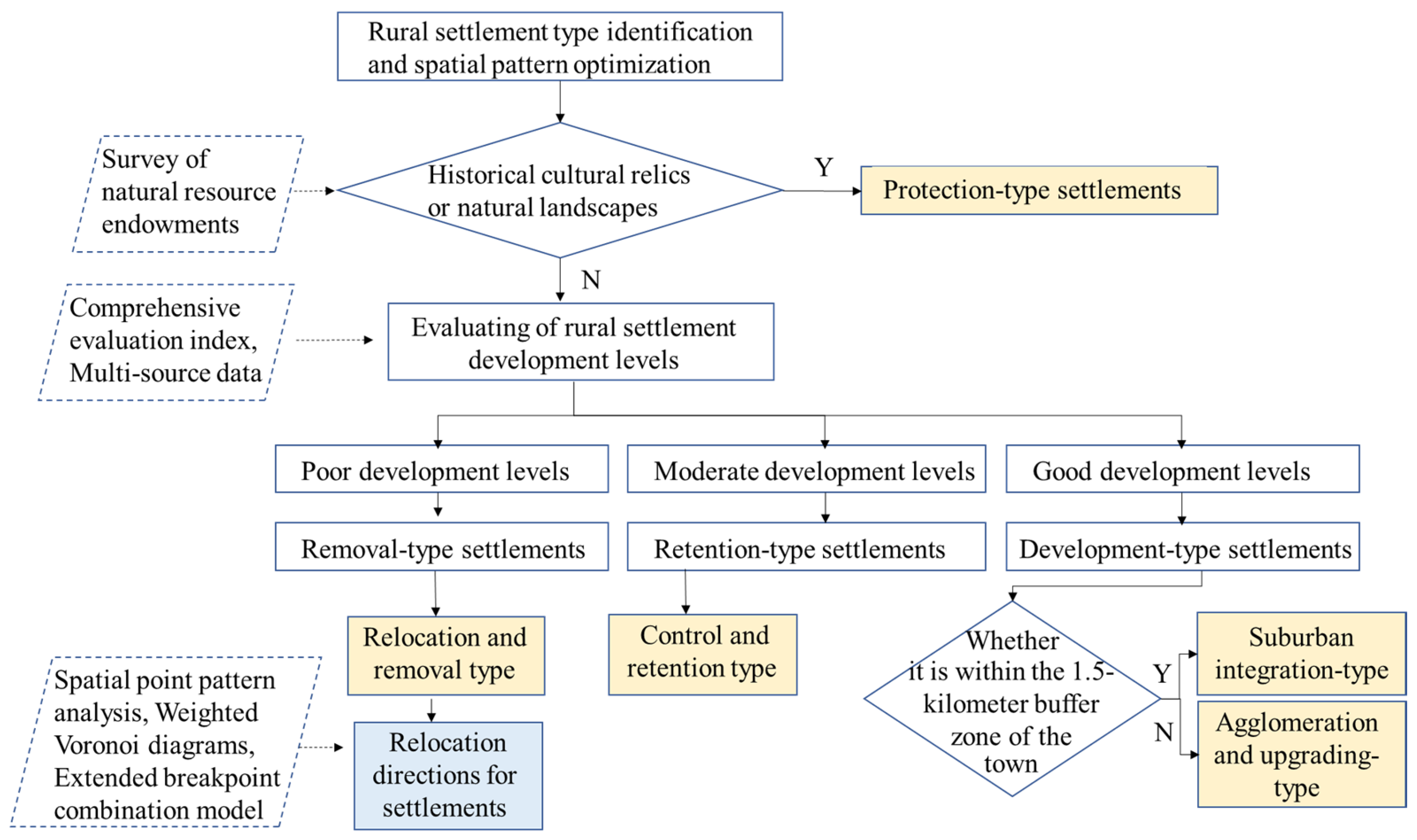
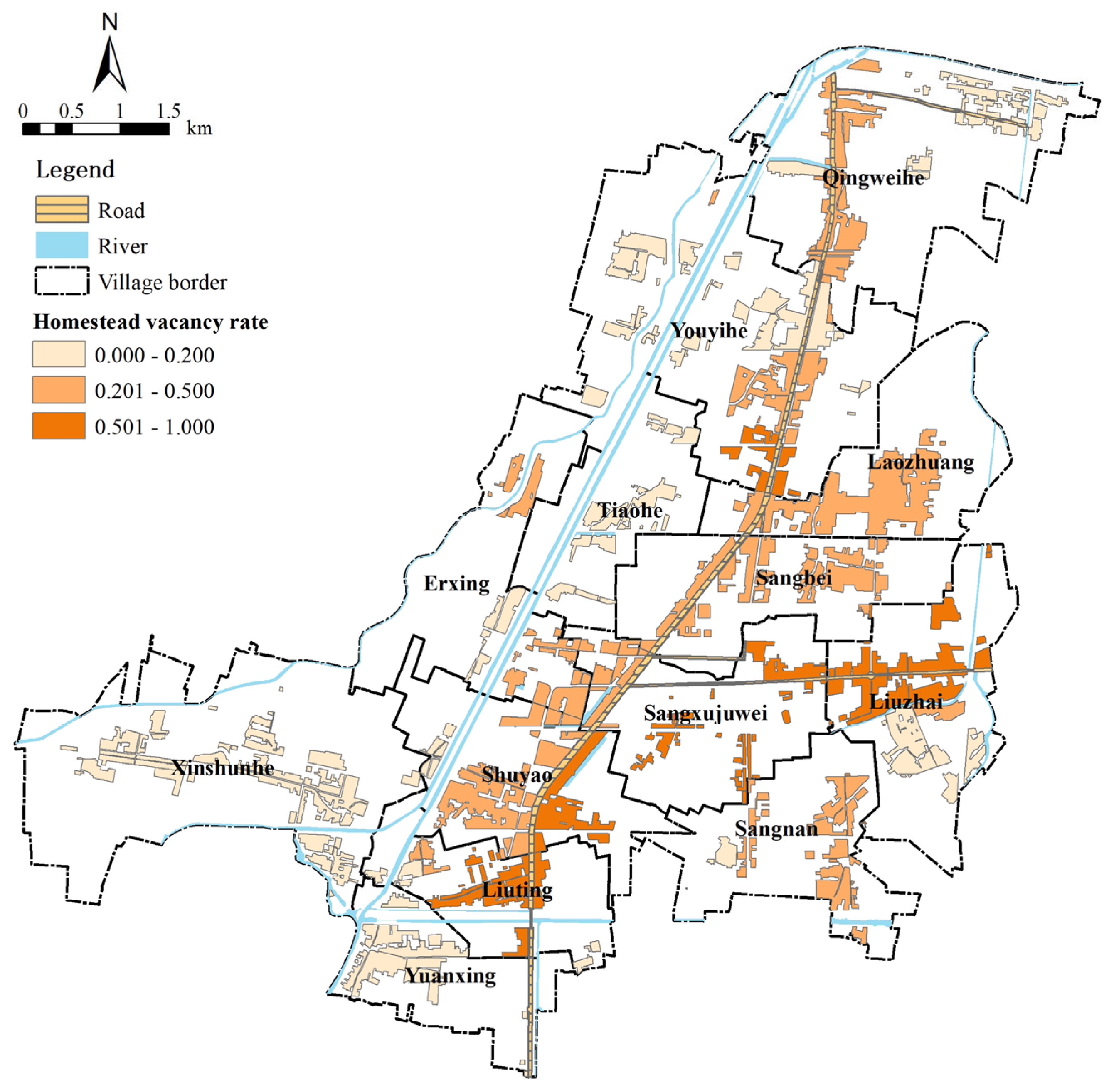
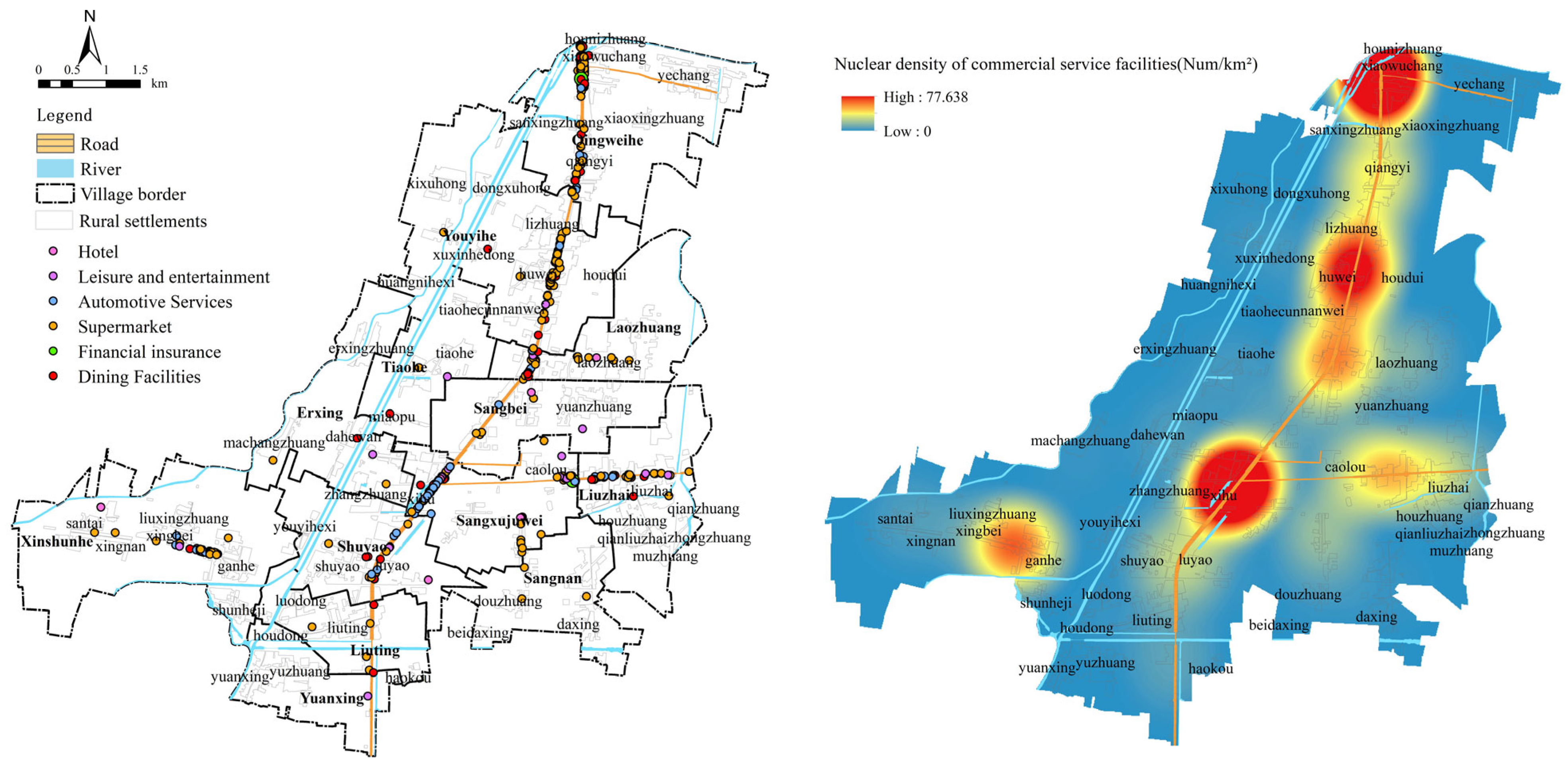
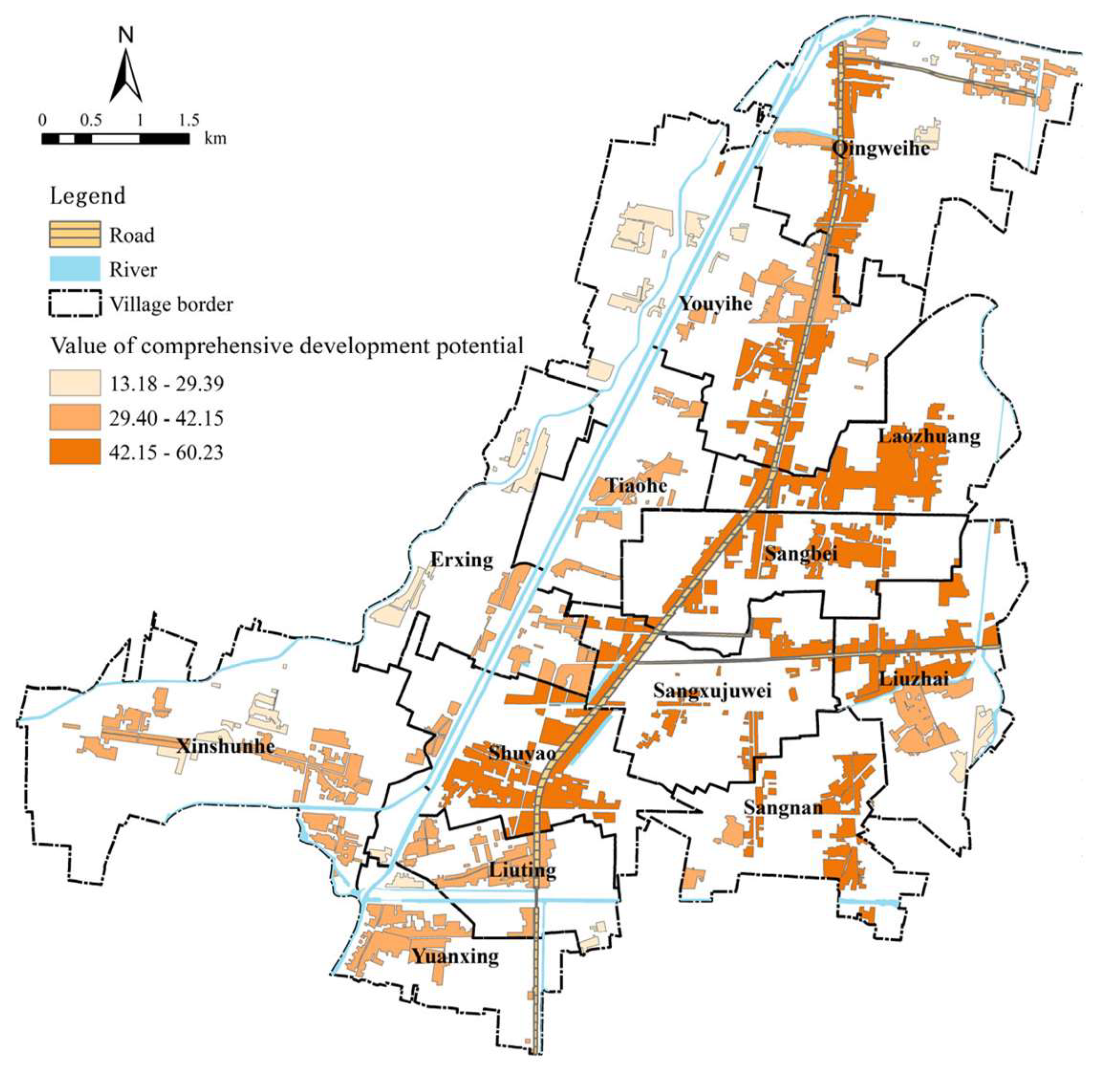
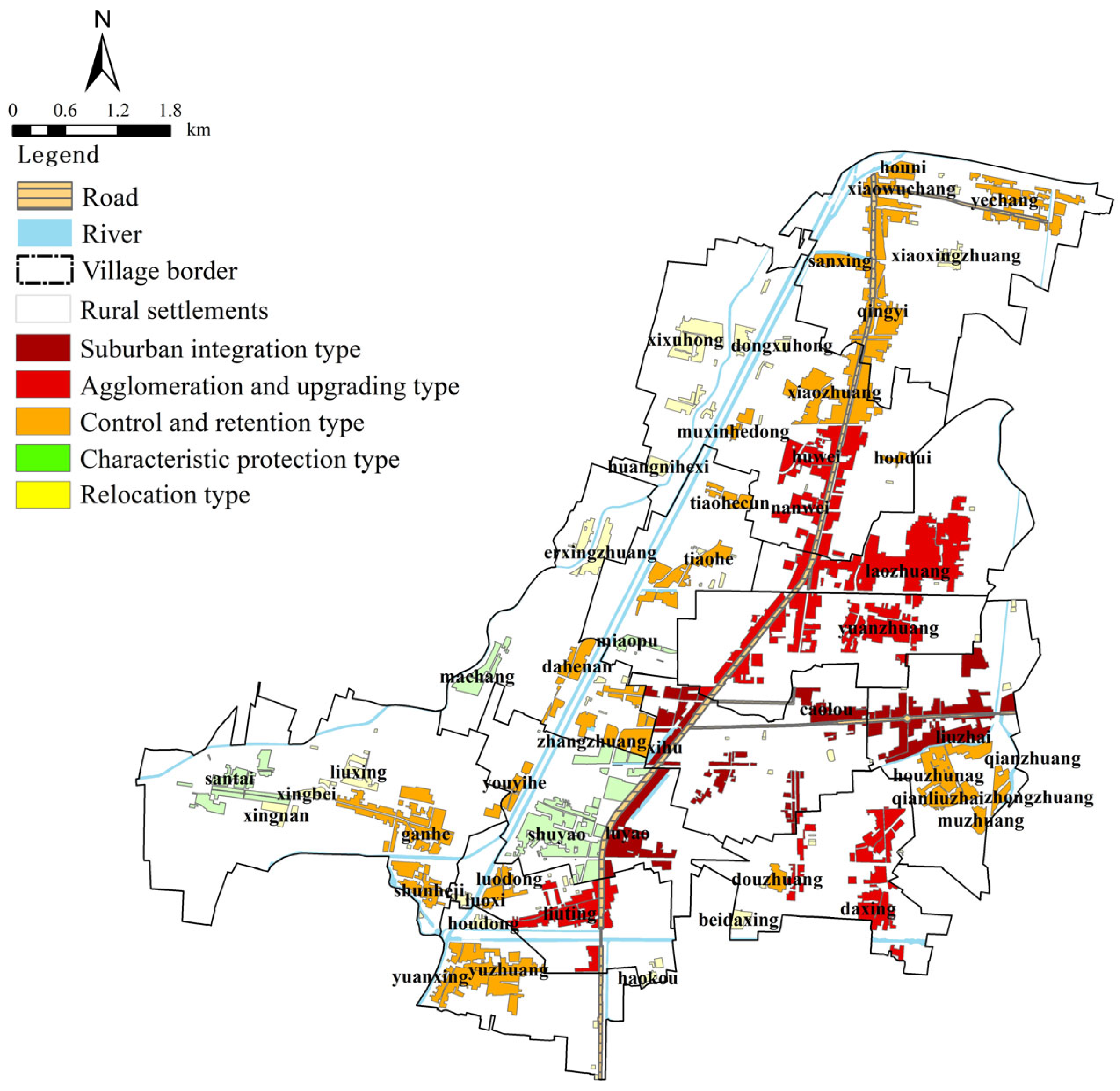


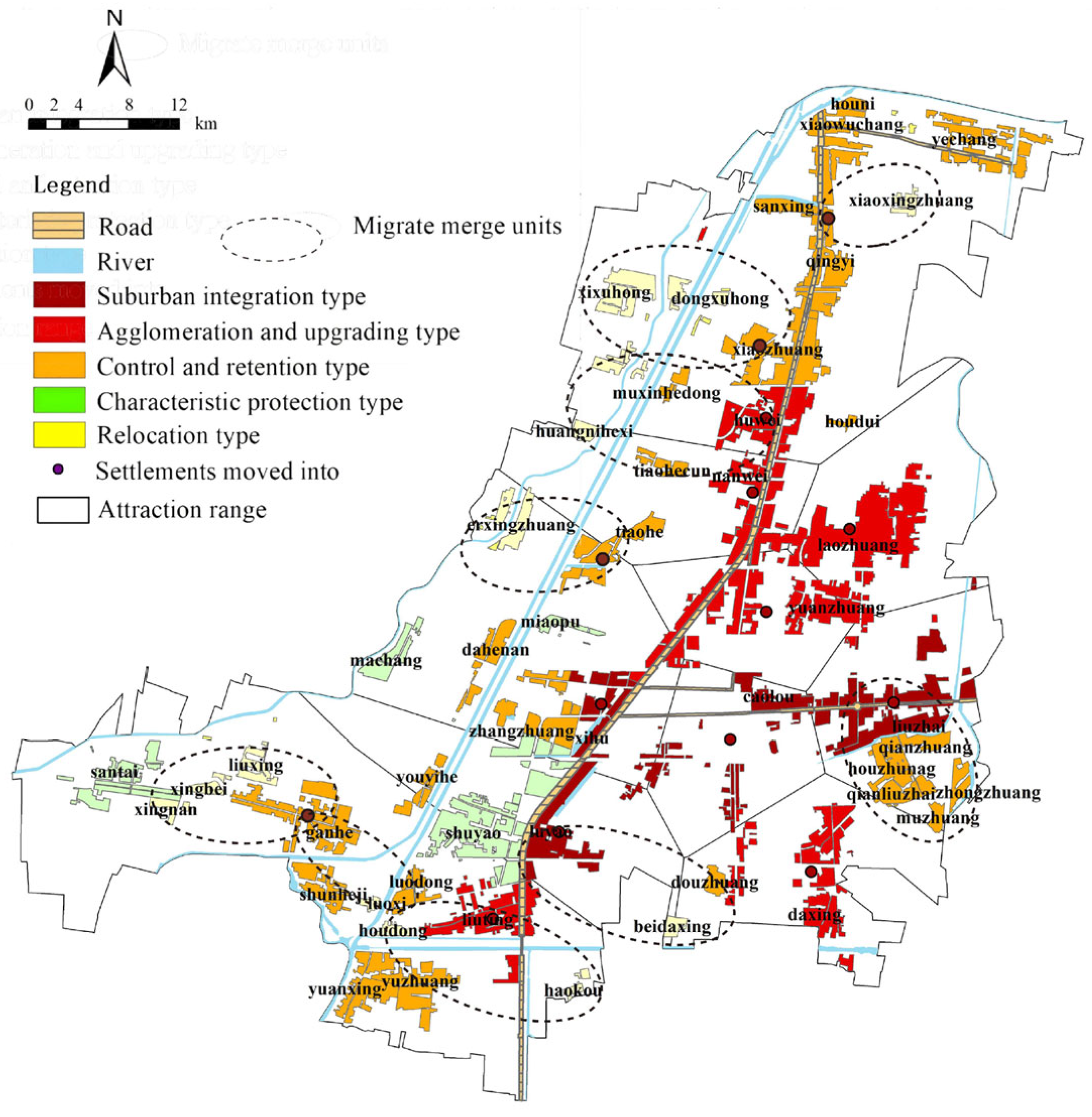
| Primary Indicators | Weight | Secondary Indicators | Indicator Explanation | Weight |
|---|---|---|---|---|
| Population Status | 0.250 | Population Size (C1) | Total registered population | 0.063 |
| Population Density (C2) | Registered population/total area of the natural village | 0.188 | ||
| Land Use | 0.250 | Per Capita Cultivated Land Area (C3) | Cultivated land area/registered population | 0.031 |
| Cultivated Land Quality (C4) | Area of fourth-grade land/total cultivated land area | 0.094 | ||
| Per Capita Construction Land Area (C5) | Construction land area/registered population | 0.031 | ||
| Resident Activity Intensity (C6) | Area of non-zero light pixels/rural settlement area | 0.094 | ||
| Industrial Development | 0.250 | Per Capita Agricultural Output (C7) | Agricultural output/registered population | 0.026 |
| Per Capita Planting Scale of Special Crops (C8) | Planting area of special crops/registered population | 0.065 | ||
| Per Unit Area Industrial Enterprise Revenue (C9) | Enterprise sales revenue/enterprise area | 0.159 | ||
| Location Conditions | 0.125 | Distance to Town (C10) | Distance from rural settlement to town center | 0.063 |
| Distance to Main Road (C11) | Distance from rural settlement to main road | 0.063 | ||
| Infrastructure Level | 0.125 | Public Service Facility Coverage (C12) | Coverage area of public service facilities/rural settlement area | 0.063 |
| Commercial Service Facility Density (C13) | Kernel density value of commercial service facilities | 0.063 |
| Type | Number | Name |
|---|---|---|
| Characteristic Protection-Type | 4 | Xinshunhe Village, Maxingzhuang Village, Tiaohe Village, Shuyao Village |
| Removal-Type | 14 | Xiaoxingzhuang, Xixuhong, Dongxuhong, Huangnihexi, Erxingzhuang, Zhongzhuang, Muzhuang, Liuzhuang, Xingbei, Xingnan, Luoxi, Houdong, Haokou |
| Control and Retention-Type | 21 | Yechang, Hounizhuang, Xiaowuchang, Sanxingzhuang, Yuzhuang, Lizhuang, Shuxinhe, Houdun, Tiaohe, Dayuwan, Zhangzhuang, Houzhuang, Qianzhuang, Yuanxing Village, Youyihe, Qianliuzhai, Douzhuang, Shunheji, Luozhong, Luodong |
| Agglomeration and Upgrading-Type | 7 | Daxingzhuang, Qingyi, Huxu, Laozhuang, Nanxu, Ganhe Community, Liuting |
| Suburban Integration-Type | 5 | West Lake, Caolouzhuang, Liuzhai, Luyao, Yuanzhuang |
| Relocation Type | Move into the Village |
|---|---|
| Xiaoxingzhuang | Qingyi |
| Xixuhong | Lizhuang |
| Dongxuhong | Lizhuang |
| Huangnihexi | Huxu |
| Erxingzhuang | Tiaohe |
| Zhongzhuang | Liuzhai |
| Muzhuang | Liuzhai |
| Liuzhuang | Luyao |
| Xingbei | Ganhe Community |
| Xingnan | Ganhe Community |
| Luoxi | Ganhe Community |
| Houdong | Liuting |
| Haokou | Liuting |
Disclaimer/Publisher’s Note: The statements, opinions and data contained in all publications are solely those of the individual author(s) and contributor(s) and not of MDPI and/or the editor(s). MDPI and/or the editor(s) disclaim responsibility for any injury to people or property resulting from any ideas, methods, instructions or products referred to in the content. |
© 2025 by the authors. Licensee MDPI, Basel, Switzerland. This article is an open access article distributed under the terms and conditions of the Creative Commons Attribution (CC BY) license (https://creativecommons.org/licenses/by/4.0/).
Share and Cite
Sun, T.; Chen, J.; Guo, J. Multi-Source Data-Driven Identification and Spatial Optimization of Rural Settlements: Evidence from Sangxu, China. Sustainability 2025, 17, 7561. https://doi.org/10.3390/su17167561
Sun T, Chen J, Guo J. Multi-Source Data-Driven Identification and Spatial Optimization of Rural Settlements: Evidence from Sangxu, China. Sustainability. 2025; 17(16):7561. https://doi.org/10.3390/su17167561
Chicago/Turabian StyleSun, Tao, Jie Chen, and Jie Guo. 2025. "Multi-Source Data-Driven Identification and Spatial Optimization of Rural Settlements: Evidence from Sangxu, China" Sustainability 17, no. 16: 7561. https://doi.org/10.3390/su17167561
APA StyleSun, T., Chen, J., & Guo, J. (2025). Multi-Source Data-Driven Identification and Spatial Optimization of Rural Settlements: Evidence from Sangxu, China. Sustainability, 17(16), 7561. https://doi.org/10.3390/su17167561





